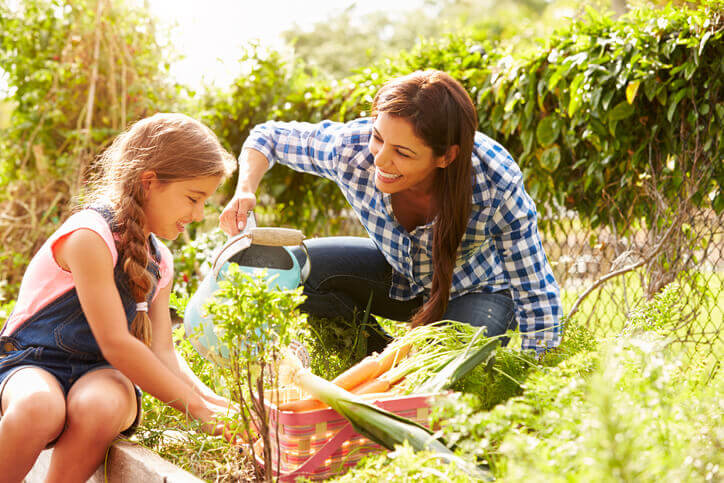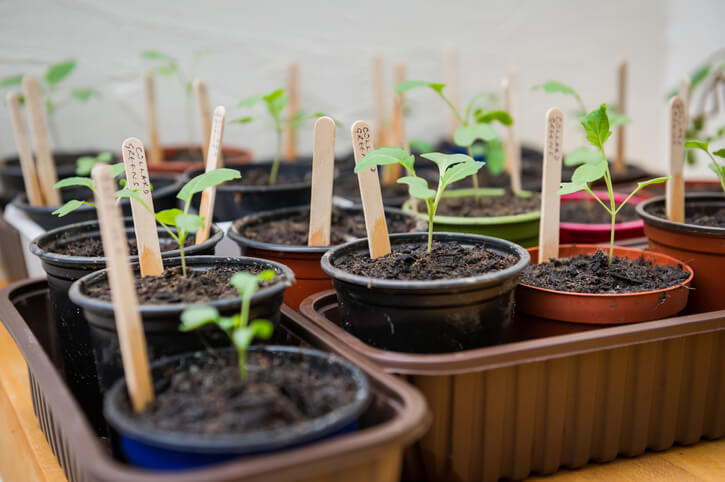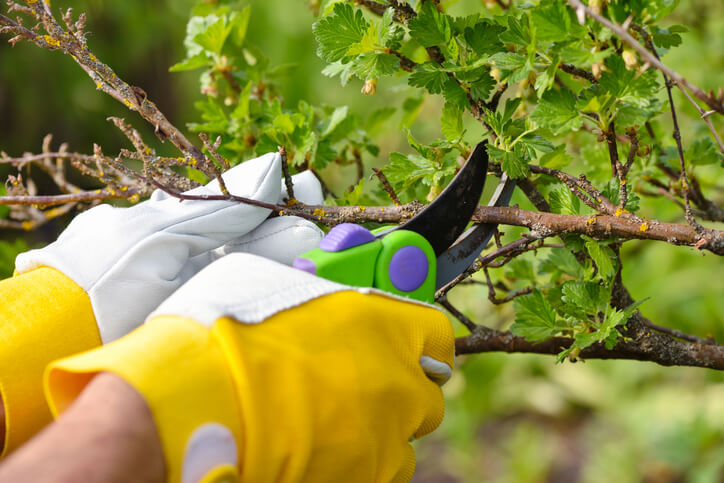
Early Spring Gardening Tips for Beginners
March 16, 2022 | Storage Tips
After a long winter, spending more time outdoors is a welcoming thought for many around the country. The coming of a new season inspires us to spend more time in our backyards, and what could be better than growing a garden? We’ve got some spring gardening tips for first-timers that are sure to kick off the season with a “bloom.”
Understand Your Climate Zone
Perhaps the most helpful and essential of our spring gardening tips is understanding the different climate types. For example, the USDA Plant Hardiness Zone Map was created to help everyone from agriculture growers to backyard gardeners understand which plants are most likely to thrive in a specific location. What is your climate zone?
Tropical Climates: These are hot and humid, with high average temperatures and abundant precipitation requiring a thoughtful approach to pest and leaf rot mitigation.
Dry Climate Zones: These zones are hot but dry, with minimal precipitation, ideally suited for low-maintenance xeriscape landscaping.
Temperate Zones: Temperate zones have warm, wet summers with rainy, mild winters making them ideal for a wide range of plants.
Continental Zones: Continental zones have warm or cool summers and cold winters with snowstorms, so choosing hardy plants and trees to survive the winter is essential.
Polar Zones: These climate zones are extremely cold in winter and relatively cool in summer, making spring gardening for beginners challenging.
Whether a vegetable, flower, tree, or shrub, the weather governs a plant’s performance. The length of your region’s growing season and amount of rainfall, winter lows, summer highs, wind, and humidity play determine what plants will and will not thrive.
Start Seedlings Indoors

There are many benefits to starting your garden with seedlings, including the joy and sense of accomplishment from watching them grow. Starting with seeds will also give you a wider variety of plant choices, such as basil and tomatoes, especially easy to start indoors.
Other easy spring gardening vegetables to grow from seedlings include radishes, lettuces, peas, string beans, cucumbers, kale, swiss chard, pumpkins, squash, and beets. Starting off with seedlings is also more economical than buying plants from the nursery.
Additionally, seeds will keep for two or more years when stored in a climate-controlled environment. However, with transplants guessing when the last frost will be is as challenging for the beginner gardener as it is with the most experienced gardeners. So you’re not alone there.
Depending on your climate zone and a little luck, start your seedlings indoors about eight weeks before transplanting them to the outdoors. Place seedling trays on your kitchen counter or window seat to serve as a constant reminder that spring gardening is just around the corner.
Know Your Soil
Besides deciding on the best location for sun exposure for your garden—early morning sun is best for growing—you’ll need to enhance or amend the soil before planting. Preparing soil correctly creates the foundation of your garden.
While there is no ideal soil for all plants—plants have their soil preferences—most vegetable and household landscaping plants prefer loamy soil (approximately 40% sand, 40% silt, and 20% clay).
Sand: Sandy soils are light and gritty to the touch. Because sandy soils have large particles, they dry out quickly, are often low in nutrients and acidic. Both water and fertilizer tend to leach out of the soil—escaping to waterways before the plant can utilize them.
Clay: Unfortunately for the beginner gardener, clay soils are classified as one of the most challenging types to manage. This soil type holds water and takes longer to warm up in early spring. Because compaction and cracking are also a considerable risk, amending clay soils with mulch, compost, or other additives is required to grow a healthy garden.
Loam: Loamy soils are the ideal soil for backyard gardeners. Loam combines sand, clay, and silt particles, making this the most fertile soil type. The balance of clay and silt particles optimizes moisture retention while the sand minimizes compaction and improves drainage. Unlike the other soil types, loamy soils don’t get dried out in the summer and don’t get water-logged in winter.
Get the Right Tools

The basic tools every gardener needs in their shed are the same for beginner and advanced gardeners. So rest easy knowing your investment will last for many seasons to come. If you’re on a budget, shop online marketplaces and garage sales for good quality used garden tools.
As an enthusiastic first-time spring gardener, it can be tempting to buy more landscaping tools than you’ll need for your spring garden. Before setting out to purchase your tools, be sure you have a dry and secure landscaping tools storage solution and stay focussed on the basics for your first spring gardening season.
Here are 8 essential garden tools to get you going on any garden project you have in mind:
Hand Trowel: Hand trowels are a must-have tool for transplanting seedlings to the garden bed, removing weeds, and container gardening. Hand trowels come in varying widths, shapes, and sizes.
A broad blade is used to move more soil, while a long, narrow blade is better suited for digging up weeds. Be sure the handle fits comfortably in your hand. Trowels forged from stainless steel are more durable and will last longer.
Waterproof Gardening Gloves: The best gardening gloves will protect your hands from thorns, splinters, and developing calluses. Choose a waterproof and durable pair of gloves that aren’t too bulky for working with plants and transplanting seedlings.
Experienced gardeners often have two types of gloves. A durable waterproof pair and a pair with longer cuffs protect wrists and forearms from scratches and keep soil from getting in.
Pruning Shears: Hand pruners are another must-have gardening tool, and the right investment will last for years to come when cared for properly. Pruning shears are best for tough and sticky stems. Find a pair with an ambidextrous design and cushioned comfort grips for slip-free use.
Garden Fork: The garden fork is shorter than a pitchfork and has four tines shaped with a horizontal curve making it an efficient tool for turning and moving soil, mulch, and compost. Garden forks also make digging dense soil easier than a spade.
Spade or Shovel: Often used interchangeably, high-quality spades and shovels are garden workhorses that can last for decades. Shovels have a concave blade with a pointed or rounded tip for digging holes for plants, edging, lifting sod, and moving small mounds of dirt from one area to another.
Spades are smaller and shorter than shovels and typically have a D-shaped handle and flat, straight-edged blade, making them useful for edging garden beds, scraping weeds, and scooping loose material.
Rake: Whether your backyard trees have leaves, pine needles, or both, a sturdy rake will help whisk them away. Rakes come in various styles and sizes, and like the spade and shovel, you’ll benefit from having two types of rakes in your garden tool shed.
A garden rake will have a long and straight handle, with short 4- to 5-inch-long tines made of sturdy metal. The tines are rigid and unmoveable, making them ideal for more challenging jobs such as breaking up compacted soil and gravel.
A leaf rake also has a long, straight handle, but the metal or plastic tines are long and slender with a curve at the end and spread out to create a fan shape. This type of rake is perfectly good at raking up leaves and is well suited for raking up any garden debris, such as gravel, sand, and pine needles.
Garden Hose with Adjustable Nozzle: Before buying a garden hose, estimate the length needed to reach the plants farthest from the hose bib. Since water is the foundation of your garden’s life, it’s important to know that there are three primary hose diameters:
- ½-inch diameter will deliver an average of 9 gal per minute.
- 5/8-inch diameter hose provides an average of 15 gal per minute.
- ¾-inch hose delivers up to 25 gal per minute.
An adjustable nozzle puts you in control of the water pressure and spray radius. Vinyl hoses are lighter and less expensive but kink easier and typically won’t last as long as rubber hoses. It’s not safe for you or your pets to drink water from a hose unless it is labeled as such.
Wheelbarrow: Whether you have a large backyard or need to move soil, compost, or pea gravel, a wheelbarrow will save your back from unnecessary strain. Wheelbarrows can help you haul hundreds of pounds of material in less time and with less fatigue.
Choose a single-handle, two-wheel model, which is easier to balance heavy loads when pushing over uneven terrain. The traditional dual-handle, single-wheel style is much harder to balance heavy or unevenly distributed loads.
Investing in these essential gardening tools will help you keep your spring garden growing beautifully and yield bountiful crops of healthy vegetables.
Seasonal Storage Solutions
Clean and conveniently located 5X10 and 10X10 storage units are frequently used for temporary, seasonal storage items like holiday decorations and landscaping equipment. If you’re lacking ample garage space, imagine a 10×10 drive-up unit as an extra secure, well-lit garage to keep your garden tools and equipment safe and dry when not in use during the winter months.
Experienced gardeners understand the value of properly maintaining and storing garden tools to preserve their investments. When you choose a state-of-the-art facility with Metro Self Storage, you’ll gain access to convenient features like 24-hour security systems, friendly service, easy online bill pay, and much more. Find a facility near you and rent your unit online today!



